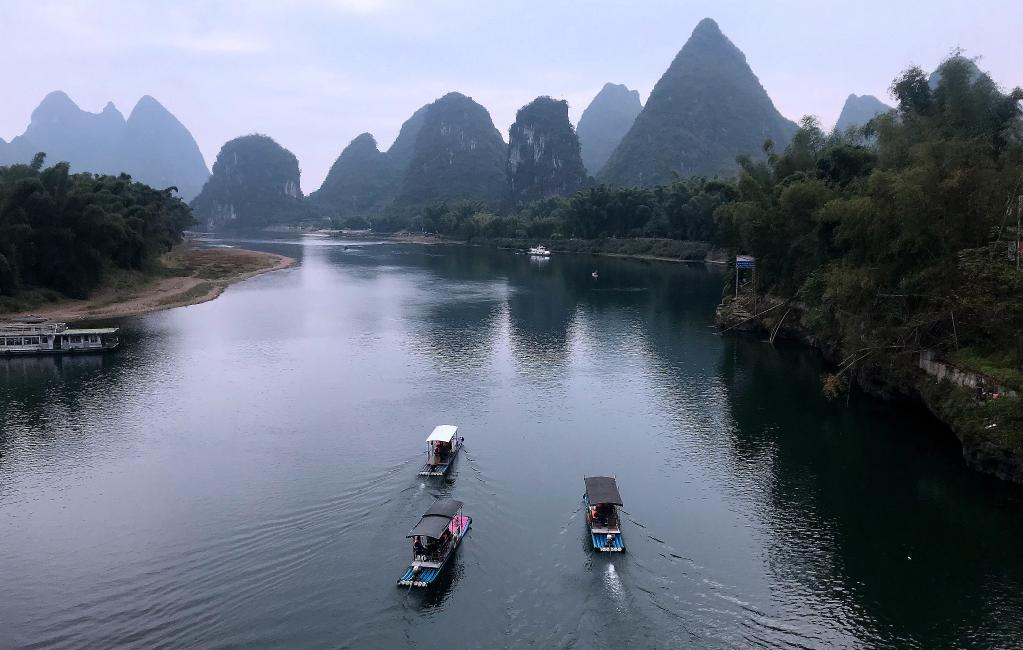Abstract : Upon arriving at a scenic spot on the Lijiang River, south China's Guangxi Zhuang Autonomous Region, Li Fang took out a 20-yuan paper note to use in a photo with her husband.

Aerial photo taken on Oct. 18, 2018 shows tourists taking a boating trip on Lijiang River in Yangshuo County of Guilin, south China’s Guangxi Zhuang Autonomous Region. (Xinhua/Zhang Ailin)
NANNING, April 25 (Xinhua) — Upon arriving at a scenic spot on the Lijiang River, south China’s Guangxi Zhuang Autonomous Region, Li Fang took out a 20-yuan paper note to use in a photo with her husband.
Printed on the back of the note is the landscape she and her husband stood in front of in Yangshuo County in the city of Guilin. The hot tourist destination was first printed on the 20-yuan note in 2000, one in the fifth set of China’s currency banknotes.
“The green mountains and lucid waters are picturesque, and I really enjoyed the environment while taking a raft downstream,” said Li, 32.
Hailed as one of the most beautiful rivers on earth, the Lijiang River stretches more than 400 km through scenic karst mountains, attracting hundreds of thousands of visitors each year.
CNN once posted a travel article on the world’s 15 best rivers for travelers, with Lijiang being listed along with the Amazon and the Danube.
According to a national water assessment result released by the Ministry of Ecology and Environment in mid-April, the Guilin Lijiang River ranked among the top 10 in the country’s water environment quality in the first quarter of this year.
The idyllic scenery is a sharp contrast to some 20 years ago when the area suffered from pollution and deforestation. Pig farms and restaurants discharged wastewater in the river, and sand-mining vessels also contaminated the water.
“We were not willing to wash vegetables in the river,” Li Yingrong, a local villager, recalled.
To pursue higher economic benefits, local villagers used to burn plants on unclaimed hills along the river to grow cash crops such as sugar orange trees.
“Deforestation and reclamation harmed the soil and water. After heavy rains in the flood season, the river water became muddy,” said Yang Lihua, Party chief of Xingping Township of Yangshuo County, recalling the scene years ago when he took office.
In 2012, China raised the vision of building a “Beautiful China,” with ecological progress included in its integrated plan for development. In the same year, the first regional regulations on ecological and environmental protection of the Lijiang River came into force, emphasizing the harmonious coexistence between humans and nature.
To protect the river, local governments rolled out a series of policies and measures and made all-out efforts to reduce pollution, including closing polluting plants and cracking down on illegal sand mining. Quarries, fish restaurants, piggeries and aquaculture farms near the river banks were shut down.
Mo Bikun, an official in charge of sewage treatment from the Guilin Drainage Project Management Office, said the city spent 619 million yuan (about 95 million U.S. dollars) building and improving the sewage pipeline network from 2015 to 2020 to prevent dirty water from flowing into the Lijiang River.
“After vigorous treatment, water in Guilin, including the Lijiang River, is getting cleaner and cleaner,” Mo said.
The improved environment has also brought tourists and revenue. In 2019, Guilin received 138 million tourists, generating consumption totaling 187.4 billion yuan, up 26.7 percent and 34.7 percent, respectively, compared with the levels in 2018.
“The cleaner river has not only delighted tourists from home and abroad, but also improved citizens’ living satisfaction,” said Mo. Enditem
About Xinhua Silk Road
Xinhua Silk Road (en.imsilkroad.com) is the Belt and Road Initiative (BRI) portal. China’s silk road economic belt and the 21st century maritime silk road website, include BRI Policy, BRI Trade, BRI Investment, Belt and Road weekly, Know Belt and Road, and the integrated information services for the Belt and Road Initiative (BRI).
Source: China Focus: Picturesque river mirrors China’s ecological progress
Comments
Post a Comment